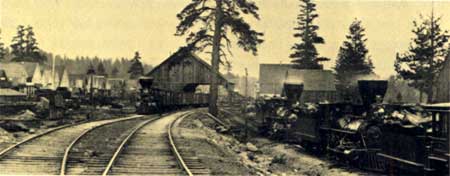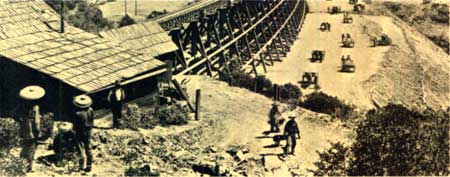|
GOLDEN SPIKE National Historic Site |
 |

Central Pacific's depot at Truckee
Stanford University
Methods of Construction
Sordid though the financial history of the Pacific Railroad may be, it is more than balanced by the dramatic construction story, in which the fieldmen of the two companies justly took pride. By completing the railroad across a 1,775-mile wilderness in less than 4 years, they set a record yet unequaled.
Both companies dealt with tremendous logistical problems. At great expense the Central Pacific had to ship by sea all equipment, tools, rolling stock, rails, bolts, and fishplates from the Atlantic Coast around Cape Horn or across the Isthmus of Panama to San Francisco. The Union Pacific, until completion of the Chicago and Northwestern to Council Bluffs in November 1867, shipped its materials and supplies to Omaha by Missouri River steamers or by wagon. Even ties, which the C.P. obtained in profusion from the Sierra, the U.P. had to import until its line reached the Black Hills of Wyoming and the Wasatch Mountains. All material, plus supplies for the army of workers, then had to be forwarded by train from the terminus to end-of-track, a transportation requirement that grew heavier with each mile the rails advanced. And beyond end-of-track the grading crews and surveying parties had to be supplied by wagon train.
During the first years, scarcity of labor delayed construction. For the Union Pacific, the end of the Civil War solved this problem. Veterans of the Union armies, mostly Irish immigrants, flocked to Omaha to enlist in Casement's grading and track gangs. The Central Pacific, however, in distant California, could not draw on this formidable labor pool. Railroad wages failed to tempt men who could earn more at the mines and perhaps, with luck, make a fortune. Strikes plagued the builders. Once, in order to break a strike, Crocker sent for some Chinese workers. They turned out to be excellent workers, and soon the Big Four were sending ships to China for recruits. By 1865 there were 7,000 Chinese, by 1868, 11,000. "Crocker's pets" they were called, and to them the word of "Mistuh Clockee" was law. Stanford later asserted that "Without them it would have been impossible to complete the western portion of this great National highway."

Chinese at work on the Central Pacific
Southern Pacific
Despite differences in financing the track-laying and grading, the basic field organization for accomplishing the work was the same for both roads. Far in advance, staking the route, ranged the surveying parties—engineers, rodmen, flagmen, chainmen, axmen, teamsters, herders, and, in Indian country, a cavalry escort. They ran preliminary surveys, followed by actual location surveys. Next came the graders. Usually they prepared 100 miles of grade at a time—on the plains in about 30 days. In the mountains it took much longer, and here the graders worked as much as 200 to 300 miles in advance of the track. Bridge, culvert, and trestle crews usually worked 5 to 20 miles from the railhead. The graders used pick and shovel for earth work, wheelbarrow and horse—or mule-drawn wagons for earth movement. For blasting cuts and tunnels through rock, they experimented with liquid nitroglycerine, but, for the most part, they used enormous quantities of black powder.
Behind the graders came the track-layers. This phase of work excited the greatest interest among spectators. A correspondent from the East described it on the Union Pacific:
A light car, drawn by a single horse, gallops up to the front with its load of rails. Two men seize the end of the rail and start forward, the rest of the gang taking hold by twos, until it is clear of the car. They come forward at a run. At the word of command the rail is dropped in its place, right side up with care, while the same process goes on at the other side of the car. Less than thirty seconds to a rail for each gang, and so four rails go down to the minute. . . . The moment the car is empty it is tipped over on the side of the track to let the next loaded car pass it, and then it is tipped back again; and it is a sight to see it go flying back for another load, propelled by a horse at full gallop at the end of 60 or 80 feet of rope, ridden by a young Jehu, who drives furiously. Close behind the first gang come the gaugers, spikers, and bolters, and a lively time they make of it. It is a grand "anvil chorus". . . . It is in triple time, three strokes to the spike. There are 10 spikes to a rail, 400 rails to a mile, 1,800 miles to San Francisco—21,000,000 times are those sledges to be swung; 21,000,000 times are they to come down with their sharp punctuation before the great work of modern America is complete.

Bear River City, Wyo., typical of the "hell-on-wheels" towns that followed the U.P. across the country.
Union Pacific
At or near end-of-track was the base camp. It consisted of construction headquarters, tents for housing the army of workers, and acres of materials and supplies to support work at the front. As rails advanced 100 to 200 miles, the camp moved forward to a new location. Adjacent to each camp along the line of the Union Pacific a tent city sprang up almost overnight. Some survived after the camp departed, while others died as quickly as they had been born. The U.P. left a trail of these towns across the country: Fremont, Kearney, North Platte, Julesburg, Sidney, Cheyenne, Laramie, Benton, Green River, Evanston, and Promontory. Until the camp moved, they were roaring centers of fun-making and frequent homicides. The population consisted chiefly of gamblers, whiskey-peddlers, prostitutes, and criminals of every variety. Together they relieved the Irishmen of most of their wages.
By contrast, the Central Pacific failed to give birth to the "hell on wheels" that characterized the Union Pacific railhead. The docile Chinese did not drink and gambled only among themselves, hence were poor material for parasites looking for easy money. Also, while the Missouri River frontier produced every type of adventurer eager to seek his fortune in the West, Californians had already come west and were content to remain. Crocker and Strobridge, moreover, imposed law and order on their towns and kept liquor and vice under a watchful control.

|
|
Last Modified: Sat, Sep 28 2002 10:00:00 pm PDT |


